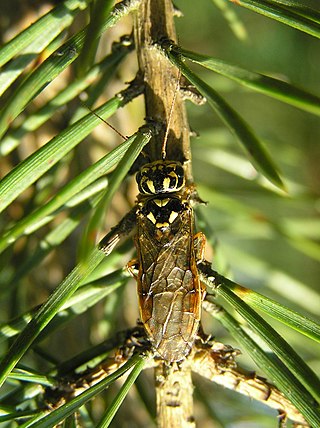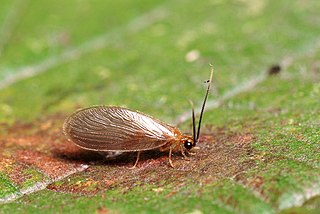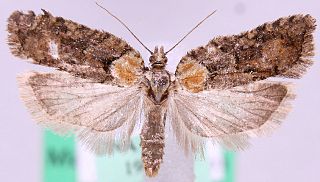
A larva is a distinct juvenile form many animals undergo before metamorphosis into their next life stage. Animals with indirect development such as insects, amphibians, or cnidarians typically have a larval phase of their life cycle.

Lepidoptera or lepidopterans is an order of winged insects which includes butterflies and moths. About 180,000 species of the Lepidoptera have been described, representing 10% of the total described species of living organisms, making it the second largest insect order with 126 families and 46 superfamilies, and one of the most widespread and widely recognizable insect orders in the world.

A crane fly is any member of the dipteran superfamily Tipuloidea, which contains the living families Cylindrotomidae, Limoniidae, Pediciidae and Tipulidae, as well as several extinct families. "Winter crane flies", members of the family Trichoceridae, are sufficiently different from the typical crane flies of Tipuloidea to be excluded from the superfamily Tipuloidea, and are placed as their sister group within Tipulomorpha.

A pupa is the life stage of some insects undergoing transformation between immature and mature stages. Insects that go through a pupal stage are holometabolous: they go through four distinct stages in their life cycle, the stages thereof being egg, larva, pupa, and imago. The processes of entering and completing the pupal stage are controlled by the insect's hormones, especially juvenile hormone, prothoracicotropic hormone, and ecdysone. The act of becoming a pupa is called pupation, and the act of emerging from the pupal case is called eclosion or emergence.

Sawflies are wasp-like insects that are in the suborder Symphyta within the order Hymenoptera, alongside ants, bees, and wasps. The common name comes from the saw-like appearance of the ovipositor, which the females use to cut into the plants where they lay their eggs. The name is associated especially with the Tenthredinoidea, by far the largest superfamily in the suborder, with about 7,000 known species; in the entire suborder, there are 8,000 described species in more than 800 genera. Symphyta is paraphyletic, consisting of several basal groups within the order Hymenoptera, each one rooted inside the previous group, ending with the Apocrita which are not sawflies.
Glowworm or glow-worm is the common name for various groups of insect larvae and adult larviform females that glow through bioluminescence. They include the European common glow-worm and other members of the Lampyridae, but bioluminescence also occurs in the families Elateridae, Phengodidae and Rhagophthalmidae among beetles; as well as members of the genera Arachnocampa, Keroplatus and Orfelia among keroplatid fungus gnats.

The caddisflies, or order Trichoptera, are a group of insects with aquatic larvae and terrestrial adults. There are approximately 14,500 described species, most of which can be divided into the suborders Integripalpia and Annulipalpia on the basis of the adult mouthparts. Integripalpian larvae construct a portable casing to protect themselves as they move around looking for food, while annulipalpian larvae make themselves a fixed retreat in which they remain, waiting for food to come to them. The affinities of the small third suborder Spicipalpia are unclear, and molecular analysis suggests it may not be monophyletic. Also called sedge-flies or rail-flies, the adults are small moth-like insects with two pairs of hairy membranous wings. They are closely related to the Lepidoptera which have scales on their wings; the two orders together form the superorder Amphiesmenoptera.

The Asilidae are the robber fly family, also called assassin flies. They are powerfully built, bristly flies with a short, stout proboscis enclosing the sharp, sucking hypopharynx. The name "robber flies" reflects their expert predatory habits; they feed mainly or exclusively on other insects and, as a rule, they wait in ambush and catch their prey in flight.

The Pamphilioidea are a small superfamily within the Symphyta, containing some 250 living species restricted to the temperate regions of Eurasia and North America. These hymenopterans share the distinctive feature of a very large, almost prognathous head, which is widest ventrally.

Gracillariidae is an important family of insects in the order Lepidoptera and the principal family of leaf miners that includes several economic, horticultural or recently invasive pest species such as the horse-chestnut leaf miner, Cameraria ohridella.

Keroplatidae is a family of small flies known as fungus gnats. About 950 species are described, but the true number of species is undoubtedly much higher. The long-beaked fungus gnats, formerly placed in a separate family Lygistorrhinidae, have been placed into Keroplatidae as subfamily Lygistorrhininae. They are generally forest dwellers found in the damp habitats favoured by their host fungi. They can also often be found in caves. Larvae both feed on fungi and are predatory - they can spin webs by secreting acid fluids, which they use to kill smaller invertebrates and capture spores. Some of the predatory larvae cannibalize pupa of their own species. The family notably includes three genera containing bioluminescent larvae.

The Mediterranean flour moth or mill moth is a moth of the family Pyralidae. It is a common pest of cereal grains, especially flour. This moth is found throughout the world, especially in countries with temperate climates. It prefers warm temperatures for more rapid development, but it can survive a wide range of temperatures.

The Trochidae, common name top-snails or top-shells, are a family of various sized sea snails, marine gastropod molluscs in the subclass Vetigastropoda. This family is commonly known as the top-snails because in many species the shell resembles a toy spinning top.

The Hydropsychidae are a family-level taxon consisting of net-spinning caddisflies. Hydropsychids are common among much of the world's streams, and a few species occupy the shorelines of freshwater lakes. Larvae of the hydropsychids construct nets at the open ends of their dwellings which are responsible for their "net-spinning caddisfly" common name.

Sisyridae, commonly known as spongeflies or spongillaflies, are a family of winged insects in the order Neuroptera. There are approximately 60 living species described, and several extinct species identified from the fossil record.

Archips podana, the large fruit-tree tortrix, is a moth of the family Tortricidae. The species was first described by Giovanni Antonio Scopoli in his 1763 Entomologia Carniolica. It is found in Europe, Asia from Anatolia to Japan and is an introduced species in North America.

Palpita vitrealis, common name jasmine moth or white pearl, is a species of moth of the family Crambidae.

Epinotia pygmaeana, the pygmy needle tortricid, is a moth of the family Tortricidae. It is found across the Palearctic from northern and central Europe to eastern Russia.
Adoxophyes privatana, the appleleaf-curling moth, is a moth of the family Tortricidae. The species was first described by Francis Walker in 1863. It is native to south-east Asia, where it has been recorded from Taiwan, Hong Kong, Hainan in China, Nepal, India, Sri-Lanka, Thailand, Vietnam, western Malaysia, Singapore, Sumatra, Java, Borneo, the Philippines and the Chagos Archipelago. It is an accidental introduction in Great Britain.

Acleris abietana, the Perth button, is a species of moth of the family Tortricidae. It is found in Europe, where it has been recorded from Great Britain, Ireland, France, Belgium, the Netherlands, Germany, Denmark, Austria, Switzerland, Italy, the Czech Republic, Slovakia, Slovenia, Poland, Hungary and Russia. The habitat consists of coniferous woodlands.


















